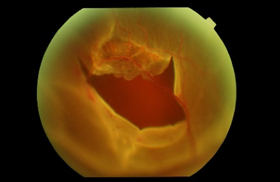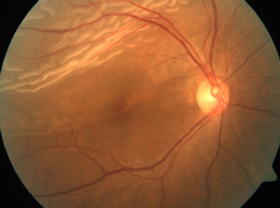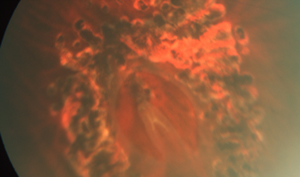Retinal tears and retinal detachments
The middle of the eyeball is filled with a transparent, sticky gel (vitreous) that is adherent to the surface of the retina (nerve layer) of the eye. During the degenerative process, the gel normally shrinks and peels away from the surface of the retina. If the gel fails to separate from the delicate retina safely, a retinal tear may develop.

Degenerating gel shrinks and pulls on the retina, and tightly adherent points may cause retinal tears. Untreated retinal tears go on to become retinal detachments.
Once a retinal tear forms, retinal detachment occurs as eye fluid seeps through the tear and underneath the retina, causing a separation between the retina and the wall of the eye. The detachment of the retina from the other supporting layers of the eye causes permanent retinal damage and results in visual loss.

A large retinal tear.

A retinal detachment with involvement of the central fixation point (macula) may permanently impair vision.
Therefore, a retinal tear is a potentially serious condition which should be treated quickly to prevent deterioration into a retinal detachment. Retinal tears are treated with laser or cryotherapy. However, once a retinal detachment develops, surgery (vitrectomy or scleral buckle) will be necessary to save vision.
Risk factors for retinal tear and retinal detachment
There are many reasons for retinal tears and retinal detachments. The most common causes are short-sightedness and increasing age. This is because short-sighted and ageing eyes tend to have thinner retina that are more likely to tear during the process of gel degeneration.
Other risk factors include previous eye surgery and eye trauma. Individuals with retinal tears and detachment in 1 eye, or with family history of retinal tears and detachment are also at increased risk.
Symptoms
An increase in floaters or frequency of lightning flashes may indicate a possible retinal tear; a shadow appearing in a corner of the visual field may be a sign of a retinal detachment. As the retinal detachment progresses, the shadow may enlarge and extend into the central visual area. Once central vision is affected, full visual recovery may not always occur even with treatment.
Therefore, a detailed eye examination should be done quickly if there are early symptoms.
Treatment
A retinal tear can be treated with laser. This should be done quickly to prevent a retinal detachment from developing. Laser treatment is done as an outpatient procedure.

A typical U-tear (horse-shoe tear).

A U-tear sealed using laser treatment.
If a retinal detachment has already occurred, surgical reattachment is necessary to prevent permanent visual loss. Surgery may involve a sclera buckle or vitrectomy. Fortunately, in most instances, detached retina can be re-attached successfully if treated early.
FAQs about retinal tears and retinal detachments
After laser treatment of retinal tears, will the floaters disappear?
The priority in treatment of retinal tears is to seal the margins of the tear so that a retinal detachment does not occur. The floaters are suspended in the gel of the eye and are untouched by the laser. Once the retinal tear is successfully treated, the floaters are considered benign and require no treatment.
Am I still at risk of retinal tears or retinal detachment if I already had LASIK for my short-sightedness and do not need to wear glasses.
LASIK reduces short-sightedness by treating the surface of the eye and does not change the structure of the gel and retina inside the eye. Since retinal tears and detachments are the result of abnormalities in the gel and retina, having had LASIK will not protect you from these conditions.
Are floaters and retinal tears due to eye strain from using the computer and watching TV?
Floaters and retinal tears are not due to eye strain from too much computer work, TV or reading. Floaters are caused by gel degeneration with age, and abnormal separation of gel from retina during the degeneration process results in retina tears.
